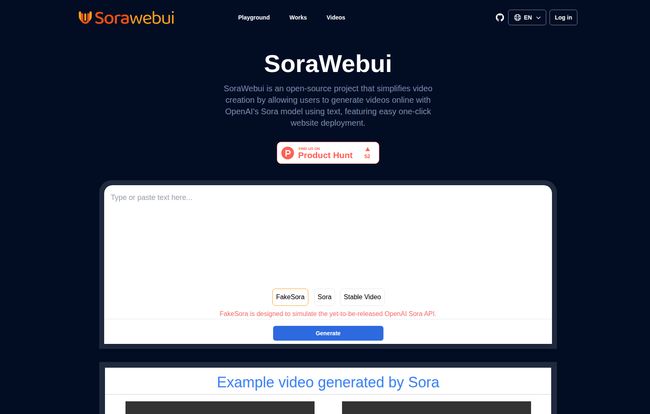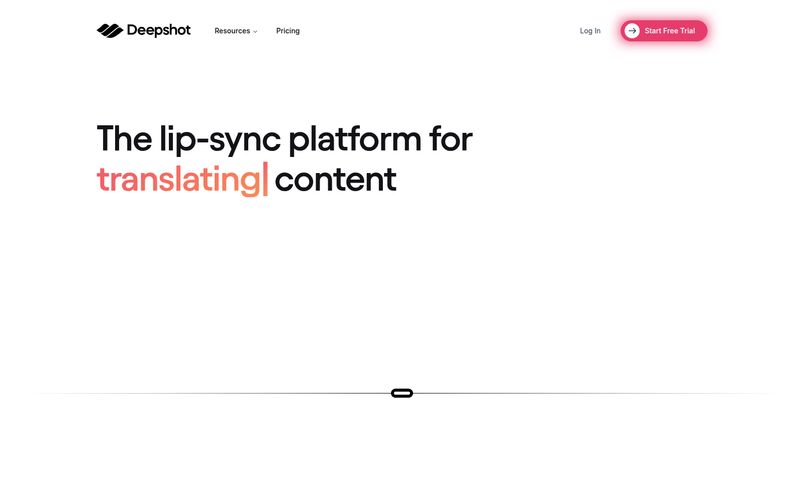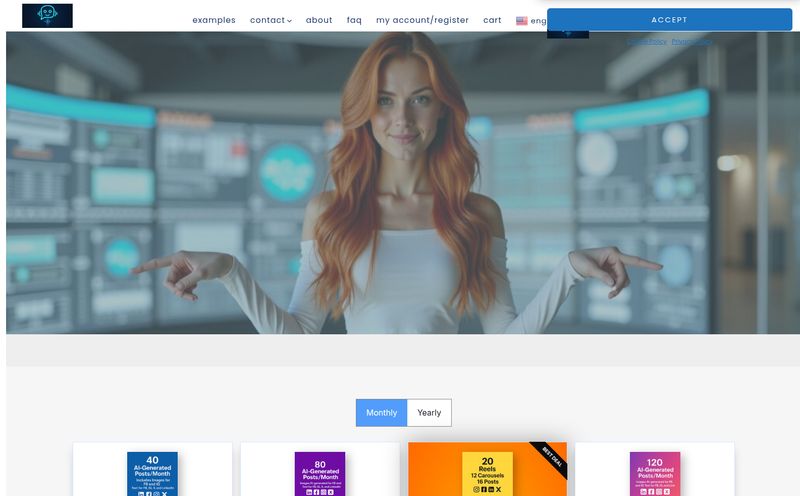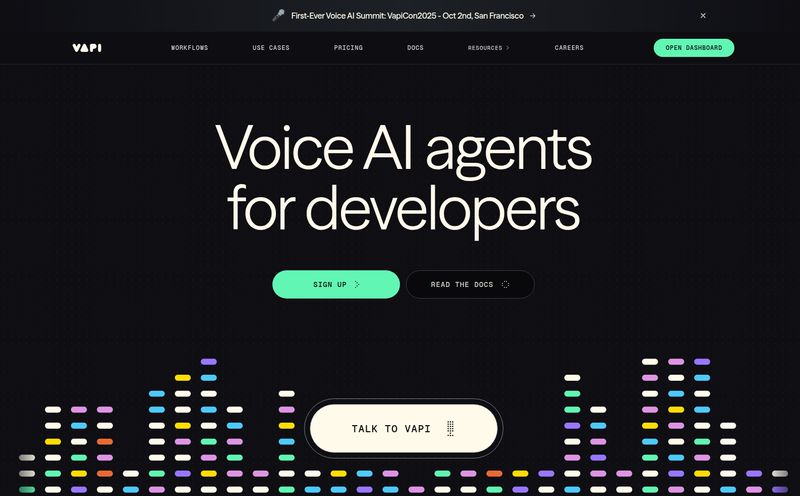Remember a few months ago? The internet had a collective meltdown. OpenAI dropped demos for Sora, its text-to-video model, and we all saw it: hyper-realistic videos of a stylish woman walking through a rain-slicked Tokyo, woolly mammoths trudging through snow... all generated from a simple text prompt. It felt like the future had just crashed our party. The only problem? We, the public, were left standing outside the venue, noses pressed against the glass. Sora was, and still is, not publicly available.
It’s the classic tech industry tease. Show us something incredible, then make us wait. But the open-source community, bless their hearts, doesn't like to wait. And that’s where a fascinating little project called SoraWebui comes into the picture.
So, What on Earth is SoraWebui?
Think of SoraWebui as a kind of waiting room for the main event. It's an open-source web platform, a clean and simple interface designed to let you generate videos from text prompts using... well, eventually, OpenAI's Sora. Its a pretty neat idea. The entire premise is to give you the feel and the framework for using Sora, so when the floodgates finally open, you're not starting from scratch.
It’s a user-friendly playground. You get a text box, you type in your wildest visual idea, and you click a button. The goal is to make the mind-bendingly complex process of AI video generation feel as simple as sending an email. And since it's open-source, it’s all about accessibility and customisation.

Visit SoraWebui
The Big Question: How Does It Work Without Sora?
This is where things get really clever. If Sora isn’t public, how can a tool be built for it? It seems like a paradox, right? The answer is a brilliant piece of developer ingenuity called FakeSoraAPI.
The Genius of the FakeSoraAPI
Okay, let's get a little nerdy for a second, because this is the heart of the project. The developers behind SoraWebui knew that programmers and creators would want to start building tools and workflows now, not later. Waiting for official API access can put you months behind.
So they built a simulator. The FakeSoraAPI is essentially a stand-in. It mimics the structure of what the real Sora API is expected to look like. It accepts the same kind of requests and parameters. But instead of calling on the real Sora, it does something else. Based on the documentation, it cleverly reroutes the request and invokes OpenAI's DALL-E model—the one for generating images.
It’s like a flight simulator for a jet that's still on the assembly line. You can't actually fly the plane yet, but you can sit in the cockpit, learn the controls, practice your maneuvers, and get your whole process down. So when the real thing is rolled out onto the tarmac, you're ready for takeoff. It's a sandbox, a practice field for the big leagues.
Who Is This Tool Actually For?
This is an important distinction to make. While anyone can visit the website and play around, the true value of SoraWebui is split between two camps.
For the Curious User
If you're just an AI enthusiast who wants to get a feel for the future of video, SoraWebui is a fun toy. You can type in prompts and see what comes out. You have to manage your expectations, of course—you're not getting those jaw-dropping Sora videos just yet. But you are interacting with an interface that's been purpose-built for the task. It’s a glimpse, a sneak peek.
For the Savvy Developer
In my opinion, this is the real target audience. If you're a developer, a content creator with a technical streak, or a business looking to integrate AI video into your workflow, SoraWebui is a gift. It allows you to build and test your applications against a simulated Sora endpoint. You can perfect your code, design your user interface around it, and get your entire backend ready. When OpenAI finally flips the switch on the real Sora API, all you'll need to do is change the endpoint. That is a huge head start.
Getting Started with SoraWebui
Getting it running is surprisingly straightforward, especially if you're a fan of one-click deployments. The project is hosted on platforms like GitHub, and you can deploy your own instance with minimal fuss. For non-technical users, the main website offers a direct interface to try it out. The whole experience is designed to be as frictionless as possible, which I can always appreciate. No one wants to spend half a day wrestling with configuration files just to try something out.
Weighing the Good and The Not-So-Good
No tool is perfect, especially one built around a technology that's not even fully released. Let's be real about it. The massive advantage is that it’s open-source, easy to use, and it’s an incredible preparatory tool for the future of AI video. It democratizes access to the process, if not the final product just yet. The spirit of it is fantastic. On the other side of the coin, its main limitation is right there in the name: the FakeSoraAPI. It's a simulation. It's not the real deal, and the output (likely still images or very short clips from other models) won't have the magic of true Sora videos. It’s a placeholder, and we need to remember that to avoid getting disappointed.
Let's Talk Money: The Price of Admission
Here’s the best part. How much does it cost to use this forward-thinking, developer-centric tool? Nothing. SoraWebui is an open-source project, meaning it’s free to use, deploy, and customize. In an industry where cutting-edge tools often come with hefty subscription fees, this is a breath of fresh air. Of course, you’ll have to account for any API costs from OpenAI if you’re using the FakeSoraAPI (which calls on DALL-E), but the platform itself is free as in speech and free as in beer.
My Final Take on SoraWebui
So, is SoraWebui worth your time? My answer is a resounding yes, but with a qualifier. If you're a developer, stop what you're doing and go check it out. It's a brilliantly practical solution to a common problem in the fast-moving AI space. If you're a casual user, go play with it, have fun, but know what it is: a preview, not the main feature.
SoraWebui is more than just a piece of software; it’s a statement. It’s a testament to the open-source community's ability to innovate and prepare for the future, even when that future is kept under lock and key. It’s a starting pistol for a race that hasn't officially begun, and it gives everyone a chance to get a running start. And in the world of SEO and digital content, a head start is everything.
Frequently Asked Questions
- 1. Is SoraWebui the same thing as OpenAI's Sora?
- No, it's not. SoraWebui is an independent, open-source user interface designed to work with OpenAI's Sora model once it becomes publicly available. For now, it uses a simulator.
- 2. Is SoraWebui free to use?
- Yes, the SoraWebui platform itself is completely free and open-source. However, you may incur costs from using the underlying AI models, like DALL-E, through their respective APIs.
- 3. What is the FakeSoraAPI I keep hearing about?
- The FakeSoraAPI is a simulation of the real Sora API. It allows developers to build applications as if they were using Sora, but it currently generates images using the DALL-E API instead of videos from Sora.
- 4. Can I create actual high-quality videos with SoraWebui right now?
- Not in the way OpenAI has demonstrated with Sora. Since the tool currently uses a simulated API that hooks into an image model, the output won't be the cinematic videos associated with Sora. Think of it as a practice tool.
- 5. Who is the ideal user for SoraWebui?
- While anyone can use it, the ideal users are developers, creators, and businesses who want to prepare their projects and workflows for the official release of OpenAI's Sora API.
- 6. Where can I find or try SoraWebui?
- You can find the project on its official website, sora-webui.com, and its code repository on GitHub. It has also been featured on Product Hunt.
Reference and Sources
- SoraWebui Official Website: https://sora-webui.com/
- OpenAI's Sora Introduction: https://openai.com/sora



